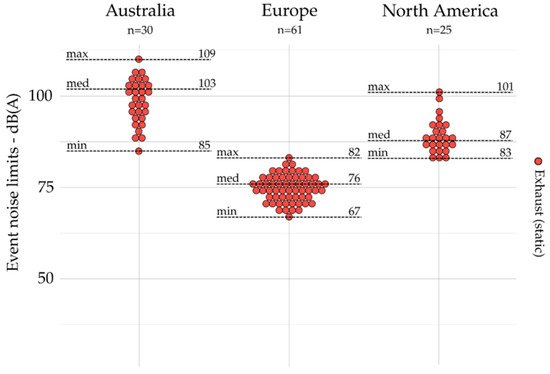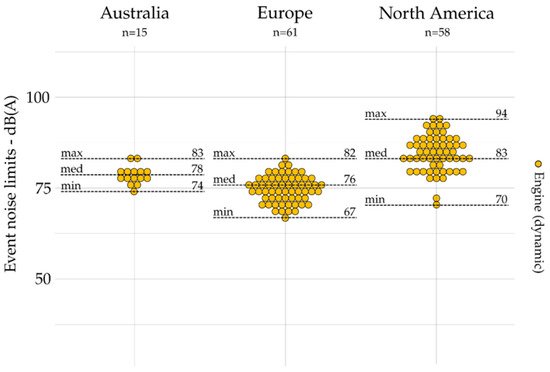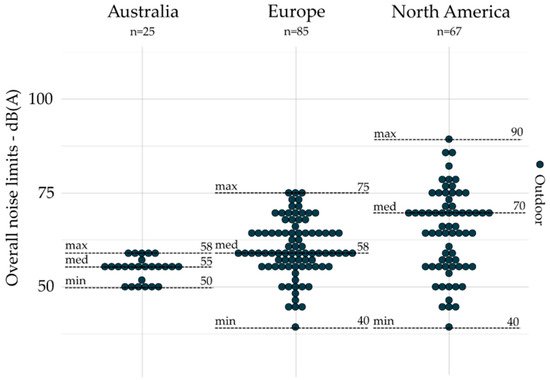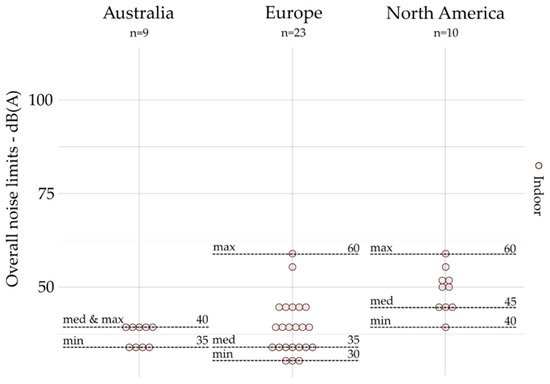You're using an outdated browser. Please upgrade to a modern browser for the best experience.
Please note this is a comparison between Version 1 by Maxime Perna and Version 2 by Nora Tang.
Developing innovative noise policies that build on international best practices is difficult when policies around the world differ along many dimensions, ranging from different sources covered to different levels of governance involved. This is particularly critical in the context of road traffic, identified as one of the main culprits leading to noise-associated complaints and health issues.
- environmental noise
- road noise limits
- road noise policies
- acoustic measurement protocols
1. Centralized and Decentralized Approaches
The detrimental effects of road traffic noise on human health can be prevented to some extent through the implementation of guidelines, directives, policies, and regulations. Furthermore, they can be set at different levels of administrative government and target either different scopes through limits of noise emission or limits of exposure.
The EU uses a centralized approach (END [1][11]) to harmonize noise maps (including road noise) between Member States by proposing a directive and a common methodology (CNOSSOS-EU [2][12]). D’Alessandro and Schiavoni [3][10] showed that the use of a common approach among Member States of the EU could improve noise efforts, provided that Member States adopt entirely the END into their own noise policies.
For emission scope, we showed that the centralized approach is mainly used for vehicles before commercial release at the highest administrative government of a country or a geographic area. For instance, in Europe, common regulations are proposed for all EU Member States. By agreeing on a common vehicle noise emissions standard, the EU has set the most ambitious targets for new vehicles. One potential reason for this is the larger vehicle market share in EU in comparison with smaller countries. Regarding noise limits for emission scope, there is a greater decibel range in Australian and North America noise limits for noise emissions regulations (i.e., engine and exhaust combined) than those set by the EU (see Figure 14 and Figure 26). It could be explained by the fact that noise regulations are set by the EU, providing a general direction for all EU Member States. In comparison, vehicle noise emission regulations are mainly regulated at the state level in Australia and North America. Each state can therefore propose different noise limits in the absence of a shared national approach.

Figure 1. Event indicators for emission (i.e., exhaust) and grouped by geographic area (n = 116).

Moreover, the differences between noise limit values identified in Australia, Europe, and North America can be explained by the different measurement protocols described in their noise regulations same as the engine speed (for exhaust noise), the vehicle speed (for engine noise), the vehicle categories, and the microphone location. For instance, the engine speed during exhaust measurements reported in Australia [4][5][19,52] can exceed the speeds used in Europe [6][7][23,24], while the vehicle passage speed during engine measurements can be higher in USA [8][45] than in Australia [4][5][19,52] and Europe [6][7][23,24]. Also, noise limits are defined for several categories of vehicle, dedicated either to freight transport or passenger transport (four wheels or less than four wheels). Finally, the microphone locations were closer to vehicles in Australia [4][5][19,52] and Europe [6][7][23,24] than in the USA [8][45].
For outdoor and indoor scopes, noise policies were decentralized because they were set at the provincial/state levels in Australia and North America and at the national level in the EU. That a local difference may be noticed in the same geographic area/country (e.g., definition of measurement periods). A decentralized approach allows for greater flexibility and adaptation to local contexts, such as working hours, involving rush hours and, therefore, noisy hours, or on the contrary, bedtime, involving times for which noise should have the least possible impact. On the other hand, the decentralized approach for outdoor and indoor may be noticed by the dispersion of noise limit values especially in Europe and North America (see Figure 32 and Figure 43). However, the values were less spread out across Australian states (decentralized approach) than in Europe and North America, while Burgess and Macpherson noticed that there was little common ground in noise limits among Australian states [9][4].

Figure 3. Overall indicators (without conversion by Brink’s method) for outdoors (all zones combined) grouped by geographic area (n = 177).

Our findings indicate that measurement protocols varied significantly among noise policies across geographic areas. For instance, Australian noise limits were defined by taking into account the facade reflections, but this is not considered in the USA and Europe. This means that Australian noise limit factors facade reflections into their measurements. It is also shown in Table 18 that noise policies refer to acoustic standard in the definition of measurement protocol. However, countries and states do not rely on the same acoustic standard, which explains the differences encountered between measurement protocols identified in noise policies. In contrast, similarities are identified between state and provincial noise policies within the same country. For instance, the ANSI S1.4 acoustic standard is referred for the type of sound level meter in Illinois [10][11][48,49] and California [12][47]. The same applies for AS 2702 acoustic standard referred for measurement protocols between Queensland [13][16] and Western Australia [14][15][17,18]. The distance of 1 or 3.5 m (by adding 2.5 dB to the measured noise level) from reflecting surfaces are also the same in Queensland, New South Wales [16][21], South Australia [17][22], and Western Australia, while the heights of the microphone above the ground are different between Queensland (1.8 m), New South Wales (1.2 m), and Western Australia (1.4 m). The same weather conditions are also referred to in Illinois and California such as a wind speed of 20 km/h (with windscreen), a temperature range of −10 and 50 °C, and the road surface must be dry during acoustic measurements. In Queensland and Western Australia, the same wind speed of 11 km/h can be found in their respective noise policies.
Table 1. Specifications of the measurement protocols in noise policies.
| Countries, States, and Provinces | Specifications | |
|---|---|---|
| Acoustic standards | Sound level meter | |
| Queensland [13] | AS 2702 5 | |
| Western Australia [14][15] | AS IEC 61672 6 (type I and II) | |
| France [18] | NF S 31-110 7 | |
| Illinois [10], California [12] | ANSI S1.4 8 (type I and II) | |
| Calibration | ||
| Western Australia [14][15] | AS IEC 60942 9 | |
| Measurement protocols | ||
| France [18] | NF S 31-085 10 | |
| Queensland [13], Western Australia [14][15] | AS 2702 11 | |
| Calibration | Queensland [13], Western Australia [14][15], California [12], Illinois [19] | before and after each measurement |
| Queensland [13], Western Australia [14][15], California [12], Illinois [19] | laboratory | |
| Measurement location | Height of the microphone above the ground | |
| New South Wales [16], South Australia [17], Ontario [20], Illinois [10], California [12] | 1.5 m | |
| Alberta [21] | 1.2 m | |
| Western Australia [14][15] | 1.4 m | |
| Queensland [13] | 1.8–4.6 m | |
| Distance from reflecting surfaces (facade or property line) | ||
| Queensland [13], Western Australia [14][15], New South Wales [16], South Australia [17] | 1 or 3.5 m (+2.5 dB) | |
| Alberta [21], France [18] | 2 m | |
| Ontario [20] | 3 m | |
| Weather conditions | Maximal wind speed | |
| Queensland [13], Western Australia [14][15] | 11 km/h | |
| Illinois [10], California [12] | 20 km/h (with windscreen) | |
| Temperature | ||
| Illinois [10], California [12] | −10 and 50 °C | |
| Rainfall | ||
| Queensland [13] | rainfall 0.3 mm/h | |
| Western Australia [14][15], Illinois [10], California [12] | road surface must be dry | |
5 Methods for the measurement of road traffic noise; 6 electroacoustics–sound-level meters; 7 Characterization and measurement of environmental noise; 8 specifications for sound-level meters; 9 electroacoustics–sound calibrators; 10 characterization and measurement of noise due to the road traffic; 11 methods for the measurement of road traffic noise.
Finally, harmonizing noise management strategies across policies could provide a common approach throughout the world, which would allow to assess and compare different populations’ noise exposure (an observation already noted for Member States of the EU [22][9]) and to adopt unified noise mitigation efforts [3][10].
2. Disparities between Noise Limits from Noise Policies Compared to the WHO Recommendations
Brink’s method for converting noise limits into common acoustic indicators allows for a comparison of outdoor noise limits with the WHO’s recommendations. Some limits are defined by Brink et al. [23][8] for the application of their conversion factors: the vehicle types and driving behaviors should be similar to Western European countries. However, the selected Western countries were similar to Western European’s countries in terms of vehicle types (i.e., noise emissions) and driving behaviors, while we showed that there are many differences between noise limits for emission regulations (engine and exhaust) across the three geographic areas, leading to differences in vehicle noise emissions. Moreover, driving behaviors are part of traffic culture, which is unique to each country [24][62]. Therefore, Brink’s method may be less suited to the study of countries where these factors might differ from Westernern Europe. In addition, this method is applicable only to overall indicators and specific measurement periods, while we showed that different event indicators and other measurement periods were also used extensively in noise policies across different countries.
In addition, the WHO’s recommendations are based exclusively on overall indicators, Lden and Ln, but some countries use event indicators (e.g., LAmax, LA10%, LA5%) to characterize noise events in order to complete overall indicators (e.g., LAeq and derivates). According to the WHO, the use of event indicators, such as LAmax, is warranted in specific situations, such as nighttime, where noise events can disrupt sleep and lead to other physiological reactions with longer-term implications. Nonetheless, the latest WHO recommendations (2018) dedicated to outdoors and road noise does not specific limit values using event indicators, because the scientific evidence on the relationship between event indicators and long-term health outcomes is limited [25][1]. For night noise, but without specifying the noise source, the WHO (2009) states, however, that there is sufficient evidence to recommend indoor values based on LAmax, varying from 32 dB(A) to 42 dB(A), in order to avoid biological effects due the fact of noise exposure and to ensure quality of sleep [26][63].
This local difference was not taken into account in the WHO’s recommendations, because the day, evening, and night were defined for specific measurement periods on the Lden and Ln indicators. The WHO defined measurement periods which did not account for the local context—people’s schedules and activities (e.g., working hours and usual bedtimes). Therefore, countries, states, and provinces should adopt the values recommended by the WHO but using definitions of measurement periods for day, evening, and night that are locally and culturally meaningful and appropriate.
Noise limits are defined according to zones, which we categorized as sensitive, residential, mixed, and industrial. Our findings indicate that all noise limits identified in residential zones (including mixed and undefined zones) exceeded the noise limit recommendations provided by the WHO, by a median of 17 dB(A) (Lden) and 18 dB(A) (Ln). In 2019, a similar study conducted by Peeters and Nusselders [27][6] showed that the majority of noise limits also exceeded the WHO’s recommendations. However, their study was limited to noise policies from EU Member States and without distinction between noise limits based on Lday and Lden. Moreover, we showed that noise limits in sensitive zones also exceeded the WHO’s recommendations, despite a higher sensitivity to noise and the greater potential for health-related effects due to the fact of noise. However, the only noise policy identified after 2018 (when the latest WHO recommendations were published) was the Western Australia policy (2019) [15][4][18,19], the other noise policies presented in this paper should therefore be updated so that the requirements tend towards the latest WHO recommendations.
Interim target values can be defined for countries where the latest WHO recommendations cannot be achieved in the short term. The concept of an interim target was proposed by the WHO (2009) for night noise (without specifying the noise source) for policy-makers who choose a stepwise approach [26][63]. The outdoor interim target, defined by the WHO (2009), is 15 dB(A) higher than the recommended Ln = 40 dB(A), also defined by the WHO (2009). Which corresponds to within a 2 dB(A) (Lden) and a 3 dB(A) (Ln) gap between the WHO’s recommendations (2018) and the medians identified for outdoor noise limits in residential zones. The EU also uses interim targets for emission noise by setting progressively more restrictive noise limits, with small gaps between target and interim targets of maximum 2 dB(A), over a ten-year period entering into effect in 2016, 2022, and 2026 [7][24]. However, to reach the WHO’s recommendations, it is important to consider strategies that go beyond noise mitigation and to include urban planning practices by integrating noise considerations throughout the planning process [22][9].
Finally, the WHO’s noise guidelines are recommended for all roads, whether they are existing, upgraded, or new. However, noise mitigation (e.g., noise barriers on highways) could be implemented during road improvement and construction works to minimize noise propagation in order to reach the WHO’s recommendations. This is also the reason why the noise limits identified in policies and defined according to the type of road may be more restrictive for upgraded and new road. On the other hand, the British Columbia [28][40] policy defines different thresholds (according to the emergence of the noise level after a road project): no impact on the communities, minor, moderate, and severe. If the project severely or moderately impacts communities, it shall be warranted to implement noise mitigation measures. More generally, population growth puts pressure on municipalities to expand, leading to the construction of new residential zones, sometimes too close to existing roads. Noise limits are therefore also set when planning dwelling areas near existing roads such as in Denmark [29][26]. Considering noise proactively in the early stages of planning could prevent noise issues by prohibiting or limiting new dwellings in the vicinity of area exposed to high noise levels.
